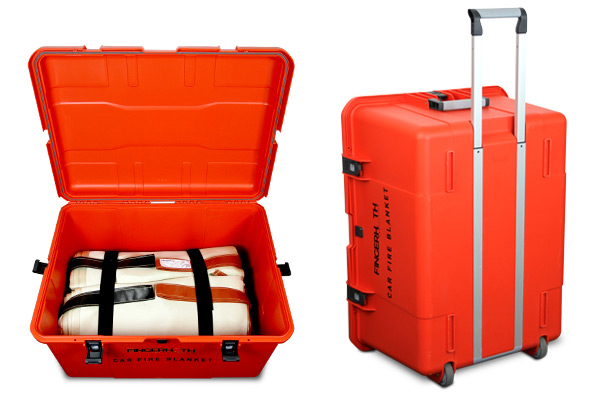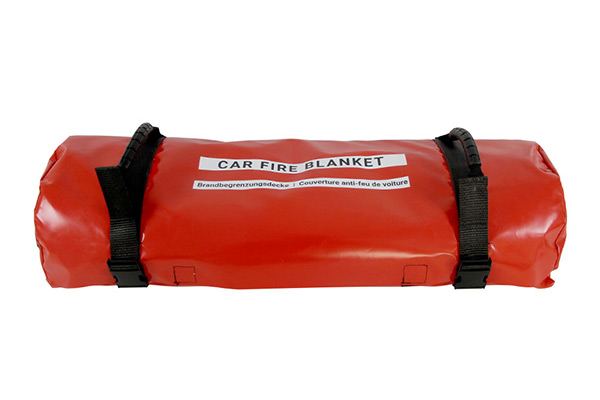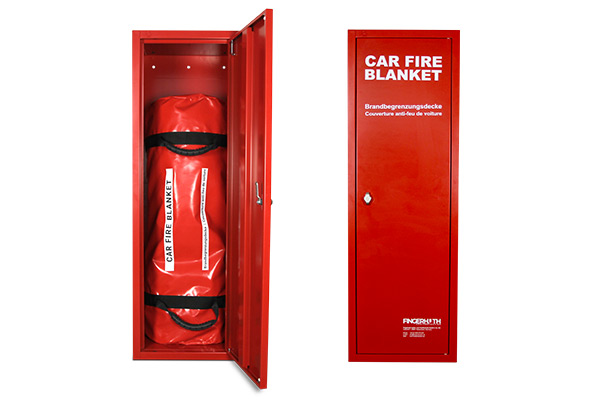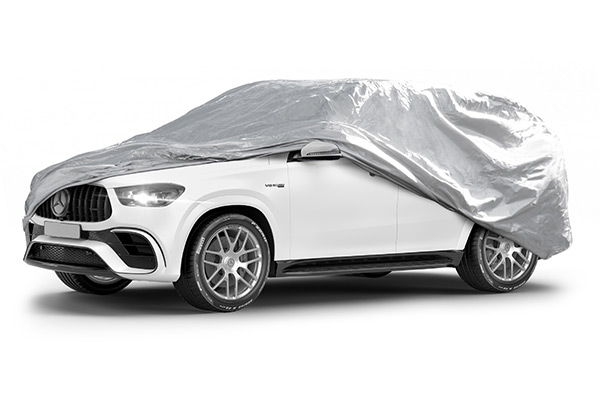Frequently Asked Questions about EV Fire Blankets (FAQ)
Battery fires, especially those caused by lithium-ion batteries, are chemical fires that cannot be extinguished using conventional methods due to their specific chemical properties. These fires are oxygen-independent, as they are fueled by internal chemical reactions within the battery. Even when the oxygen supply is cut off, these reactions continue.
Fire containment blankets play a vital role in combating battery fires in e-cars, e-vehicles, and e-tools. They are designed to quickly and effectively isolate the burning object, preventing the spread of flames and heat. Their fireproof and heat-resistant materials protect surrounding areas and help avoid escalation. Fire containment blankets are especially valuable for buying time for evacuations or initiating further firefighting measures.
For e-bikes, e-scooters, and e-tools: One person is usually sufficient to apply smaller fire containment blankets (up to 3 x 4 meters). However, to ensure safer and easier handling, it is recommended to have at least one additional person assist.
For e-cars and e-vehicles: At least two people are required to apply larger fire containment blankets on e-cars and e-vehicles. In confined or difficult conditions, involving more people can make placement more precise and secure.
For conventional fires: Oxygen-dependent fires are typically extinguished within minutes by cutting off the oxygen supply. However, the fire containment blanket should remain on the fire source for at least 30 minutes to ensure no re-ignition occurs.
For battery fires: Battery fires are oxygen-independent and can burn longer depending on the battery size. The fire containment blanket should stay on the source for at least 45–60 minutes. For e-cars or large battery units, the blanket should remain in place for 24 to 120 hours due to the risk of re-ignition, especially if high temperatures persist. Cooling with water can reduce fire duration and enhance safety. Continuous monitoring of the battery unit’s temperature is essential.
In general, the use of a fire containment blanket does not require additional extinguishing agents. Oxygen-dependent fires can be reliably extinguished using the blanket without the need for water or foam.
For battery fires, especially in e-cars, it may be useful to assess the situation individually. To enhance safety, cooling the burning vehicle and its surroundings with water can help lower temperatures and prevent fire spread or re-ignition of the battery cells.
For conventional fires: Fire blankets of the "H-TYPE" are recommended for oxygen-dependent fires. These blankets are heat-resistant up to 1000 °C and feature a double-sided silicone coating, which makes them gas-tight and effectively cuts off the oxygen supply, extinguishing the flames.
For smaller battery fires: Lithium-ion batteries or tool batteries can also be isolated using "H-TYPE" fire blankets.
For e-cars and larger e-vehicles: Thermal events in e-cars or larger e-vehicles can reach temperatures of up to 1200 °C and involve prolonged fires due to the high battery capacity. For these cases, "S-TYPE" or "X-TYPE" fire containment blankets are recommended. These blankets are specifically designed to withstand higher temperatures and allow gases to escape through the fabric structure in a controlled manner, preventing hazardous ballooning.
Fire containment blankets from Fingerhuth are weather-resistant, UV-resistant, durable, and maintenance-free. Regular maintenance is not required. However, it is recommended to inspect the blanket for possible damage after a drill or similar use to ensure it remains fully operational.
Yes, all components and materials of our fire containment blankets are safe for health. They are not classified as hazardous materials and can be used without concern.
Reusing fire containment blankets after use on an e-car or e-vehicle is generally discouraged, as recommended by many experts. During a battery fire, the blanket is exposed to extreme temperatures of up to 1200 °C and contaminated with toxic gases and particles that may off-gas during further storage, posing health risks.
Additionally, invisible damage such as brittleness or fiber breaks can occur, which are difficult for untrained individuals to detect. These damages significantly compromise the safety and reliability of the blanket. Therefore, it is recommended to dispose of the blanket after use and avoid reuse.
For conventional fires using an "H-TYPE" blanket, reuse is generally possible. However, this depends on the fire load and mechanical stress during use. After each use, the blanket should be thoroughly inspected for damage to ensure its continued effectiveness.



















